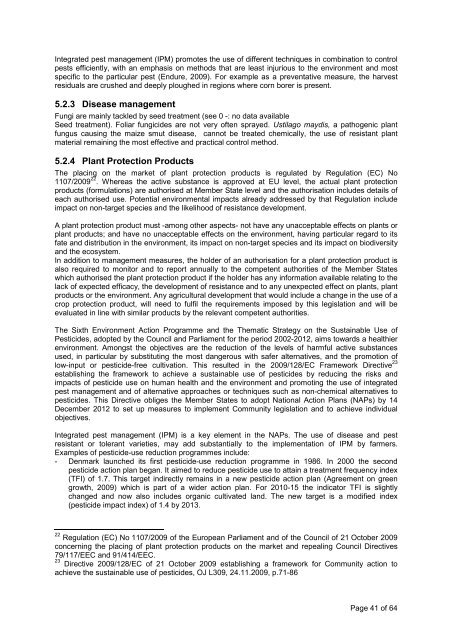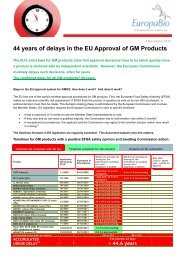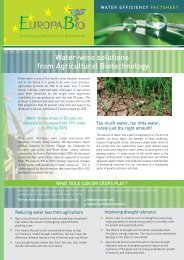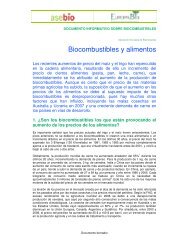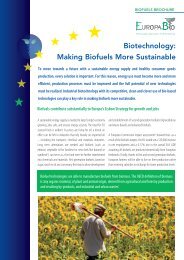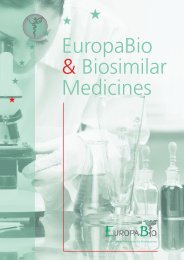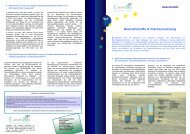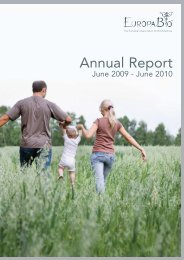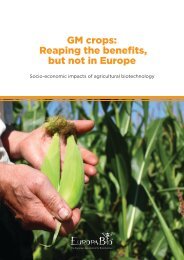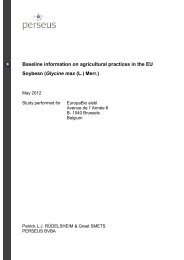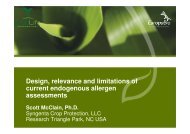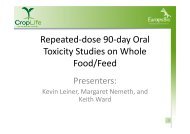Baseline information on agricultural practices in the EU ... - Europabio
Baseline information on agricultural practices in the EU ... - Europabio
Baseline information on agricultural practices in the EU ... - Europabio
Create successful ePaper yourself
Turn your PDF publications into a flip-book with our unique Google optimized e-Paper software.
Integrated pest management (IPM) promotes <strong>the</strong> use of different techniques <strong>in</strong> comb<strong>in</strong>ati<strong>on</strong> to c<strong>on</strong>trol<br />
pests efficiently, with an emphasis <strong>on</strong> methods that are least <strong>in</strong>jurious to <strong>the</strong> envir<strong>on</strong>ment and most<br />
specific to <strong>the</strong> particular pest (Endure, 2009). For example as a preventative measure, <strong>the</strong> harvest<br />
residuals are crushed and deeply ploughed <strong>in</strong> regi<strong>on</strong>s where corn borer is present.<br />
5.2.3 Disease management<br />
Fungi are ma<strong>in</strong>ly tackled by seed treatment (see 0 -: no data available<br />
Seed treatment). Foliar fungicides are not very often sprayed. Ustilago maydis, a pathogenic plant<br />
fungus caus<strong>in</strong>g <strong>the</strong> maize smut disease, cannot be treated chemically, <strong>the</strong> use of resistant plant<br />
material rema<strong>in</strong><strong>in</strong>g <strong>the</strong> most effective and practical c<strong>on</strong>trol method.<br />
5.2.4 Plant Protecti<strong>on</strong> Products<br />
The plac<strong>in</strong>g <strong>on</strong> <strong>the</strong> market of plant protecti<strong>on</strong> products is regulated by Regulati<strong>on</strong> (EC) No<br />
1107/2009 22 . Whereas <strong>the</strong> active substance is approved at <strong>EU</strong> level, <strong>the</strong> actual plant protecti<strong>on</strong><br />
products (formulati<strong>on</strong>s) are authorised at Member State level and <strong>the</strong> authorisati<strong>on</strong> <strong>in</strong>cludes details of<br />
each authorised use. Potential envir<strong>on</strong>mental impacts already addressed by that Regulati<strong>on</strong> <strong>in</strong>clude<br />
impact <strong>on</strong> n<strong>on</strong>-target species and <strong>the</strong> likelihood of resistance development.<br />
A plant protecti<strong>on</strong> product must -am<strong>on</strong>g o<strong>the</strong>r aspects- not have any unacceptable effects <strong>on</strong> plants or<br />
plant products; and have no unacceptable effects <strong>on</strong> <strong>the</strong> envir<strong>on</strong>ment, hav<strong>in</strong>g particular regard to its<br />
fate and distributi<strong>on</strong> <strong>in</strong> <strong>the</strong> envir<strong>on</strong>ment, its impact <strong>on</strong> n<strong>on</strong>-target species and its impact <strong>on</strong> biodiversity<br />
and <strong>the</strong> ecosystem.<br />
In additi<strong>on</strong> to management measures, <strong>the</strong> holder of an authorisati<strong>on</strong> for a plant protecti<strong>on</strong> product is<br />
also required to m<strong>on</strong>itor and to report annually to <strong>the</strong> competent authorities of <strong>the</strong> Member States<br />
which authorised <strong>the</strong> plant protecti<strong>on</strong> product if <strong>the</strong> holder has any <str<strong>on</strong>g><strong>in</strong>formati<strong>on</strong></str<strong>on</strong>g> available relat<strong>in</strong>g to <strong>the</strong><br />
lack of expected efficacy, <strong>the</strong> development of resistance and to any unexpected effect <strong>on</strong> plants, plant<br />
products or <strong>the</strong> envir<strong>on</strong>ment. Any <strong>agricultural</strong> development that would <strong>in</strong>clude a change <strong>in</strong> <strong>the</strong> use of a<br />
crop protecti<strong>on</strong> product, will need to fulfil <strong>the</strong> requirements imposed by this legislati<strong>on</strong> and will be<br />
evaluated <strong>in</strong> l<strong>in</strong>e with similar products by <strong>the</strong> relevant competent authorities.<br />
The Sixth Envir<strong>on</strong>ment Acti<strong>on</strong> Programme and <strong>the</strong> Thematic Strategy <strong>on</strong> <strong>the</strong> Susta<strong>in</strong>able Use of<br />
Pesticides, adopted by <strong>the</strong> Council and Parliament for <strong>the</strong> period 2002-2012, aims towards a healthier<br />
envir<strong>on</strong>ment. Am<strong>on</strong>gst <strong>the</strong> objectives are <strong>the</strong> reducti<strong>on</strong> of <strong>the</strong> levels of harmful active substances<br />
used, <strong>in</strong> particular by substitut<strong>in</strong>g <strong>the</strong> most dangerous with safer alternatives, and <strong>the</strong> promoti<strong>on</strong> of<br />
low-<strong>in</strong>put or pesticide-free cultivati<strong>on</strong>. This resulted <strong>in</strong> <strong>the</strong> 2009/128/EC Framework Directive 23<br />
establish<strong>in</strong>g <strong>the</strong> framework to achieve a susta<strong>in</strong>able use of pesticides by reduc<strong>in</strong>g <strong>the</strong> risks and<br />
impacts of pesticide use <strong>on</strong> human health and <strong>the</strong> envir<strong>on</strong>ment and promot<strong>in</strong>g <strong>the</strong> use of <strong>in</strong>tegrated<br />
pest management and of alternative approaches or techniques such as n<strong>on</strong>-chemical alternatives to<br />
pesticides. This Directive obliges <strong>the</strong> Member States to adopt Nati<strong>on</strong>al Acti<strong>on</strong> Plans (NAPs) by 14<br />
December 2012 to set up measures to implement Community legislati<strong>on</strong> and to achieve <strong>in</strong>dividual<br />
objectives.<br />
Integrated pest management (IPM) is a key element <strong>in</strong> <strong>the</strong> NAPs. The use of disease and pest<br />
resistant or tolerant varieties, may add substantially to <strong>the</strong> implementati<strong>on</strong> of IPM by farmers.<br />
Examples of pesticide-use reducti<strong>on</strong> programmes <strong>in</strong>clude:<br />
- Denmark launched its first pesticide-use reducti<strong>on</strong> programme <strong>in</strong> 1986. In 2000 <strong>the</strong> sec<strong>on</strong>d<br />
pesticide acti<strong>on</strong> plan began. It aimed to reduce pesticide use to atta<strong>in</strong> a treatment frequency <strong>in</strong>dex<br />
(TFI) of 1.7. This target <strong>in</strong>directly rema<strong>in</strong>s <strong>in</strong> a new pesticide acti<strong>on</strong> plan (Agreement <strong>on</strong> green<br />
growth, 2009) which is part of a wider acti<strong>on</strong> plan. For 2010-15 <strong>the</strong> <strong>in</strong>dicator TFI is slightly<br />
changed and now also <strong>in</strong>cludes organic cultivated land. The new target is a modified <strong>in</strong>dex<br />
(pesticide impact <strong>in</strong>dex) of 1.4 by 2013.<br />
22 Regulati<strong>on</strong> (EC) No 1107/2009 of <strong>the</strong> European Parliament and of <strong>the</strong> Council of 21 October 2009<br />
c<strong>on</strong>cern<strong>in</strong>g <strong>the</strong> plac<strong>in</strong>g of plant protecti<strong>on</strong> products <strong>on</strong> <strong>the</strong> market and repeal<strong>in</strong>g Council Directives<br />
79/117/EEC and 91/414/EEC.<br />
23 Directive 2009/128/EC of 21 October 2009 establish<strong>in</strong>g a framework for Community acti<strong>on</strong> to<br />
achieve <strong>the</strong> susta<strong>in</strong>able use of pesticides, OJ L309, 24.11.2009, p.71-86<br />
Page 41 of 64


